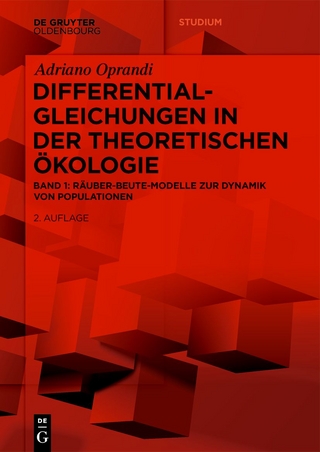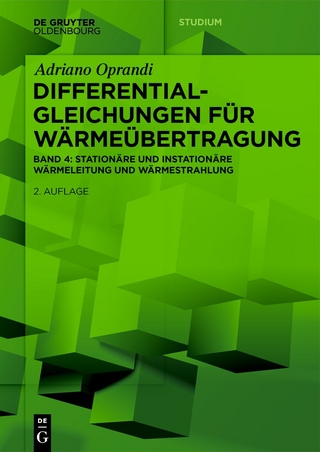
Dynamics Reported
Springer-Verlag Berlin and Heidelberg GmbH & Co. K
978-3-540-60165-4 (ISBN)
- Titel ist leider vergriffen;
keine Neuauflage - Artikel merken
DYNAMICS REPORTED reports on recent developments in dynamical systems. Dynamical systems of course originated from ordinary differential equations. Today, dynamical systems cover a much larger area, including dynamical processes described by functional and integral equations, by partial and stochastic differential equations, etc. Dynamical systems have involved remarkably in recent years. A wealth of new phenomena, new ideas and new techniques are proving to be of considerable interest to scientists in rather different fields. It is not surprising that thousands of publications on the theory itself and on its various applications are appearing DYNAMICS REPORTED presents carefully written articles on major subjects in dynam- ical systems and their applications, addressed not only to specialists but also to a broader range of readers including graduate students. Topics are advanced, while detailed expo- sition of ideas, restriction to typical results - rather than the most general ones - and, last but not least, lucid proofs help to gain the utmost degree of clarity.
It is hoped, that DYNAMICS REPORTED will be useful for those entering the field and will stimulate an exchange of ideas among those working in dynamical systems Summer 1991 Christopher K. R. T Jones Drs Kirchgraber Hans-Otto Walther Managing Editors Table of Contents Hyperbolicity and Exponential Dichotomy for Dynamical Systems Neil Fenichel 1. Introduction ...I 2. The Main Lemma ...2 3. The Linearization Theorem of Hartman and Grobman 5 4. Hyperbolic Invariant Sets: -orbits and Stable Manifolds 6 5.
Hyperbolicity and Exponential Dichotomy for Dynamical Systems.- 1. Introduction.- 2. The Main Lemma.- 3. The Linearization Theorem of Hartman and Grobman.- 4. Hyperbolic Invariant Sets: e-orbits and Stable Manifolds.- 5. Structural Stability of Anosov Diffeomorphisms.- 6. Periodic Points of Anosov Diffeomorphisms.- 7. Axiom A Diffeomorphisms: Spectral Decomposition.- 8. The In-Phase Theorem.- 9. Flows.- 10. Proof of Lemma 1.- References.- Feedback Stabilizability of Time-Periodic ParabolicEquations.- 0. Introduction.- I. Linear Periodic Evolution Equations.- 1. The Evolution Operator.- 2. The Evolution Operator in Interpolation Spaces.- 3. Periodic Problems.- 4. Exponential Stability of the Zero Solution.- 5. The Stable and Unstable Subspaces.- 6. Autonomizing the Unstable Part.- II. Controllability, Observability and Feedback Stabilizability.- 7. The Feedback Stabilizability Problem.- 8. Finite Dimensional Theory.- 9. The Standard Assumption.- 10. Controllability and Feedback Stabilizability.- 11. Observability and Feedback Stabilizability.- III. Applications to Second Order Time-Periodic Parabolic Initial-Boundary Value Problems.- 12. Evolution Equations in Interpolation and Extrapolation Spaces.- A. Semigroups in Interpolation and Extrapolation Spaces.- B. Evolution Operators in Interpolation-Extrapolation Spaces.- C. The Cauchy-Problem.- D. Identifying the Dual of the Evolution Operator.- 13. Second Order Elliptic Boundary Value Problems.- A. Strongly Uniformly Elliptic Boundary Value Problems.- B. Function Spaces with Boundary Conditions.- C. The Lp-Realization.- D. The Dirichlet Form.- 14. Second Order Parabolic Initial-Boundary Value Problems.- A. General Assumptions.- B. The Lp-Realization.- C. Affine Perturbations.- 15. The Feedback Equation.- 16. The Free System.- A. Some Notation.- B. Regularity of the Eigenfunctions.- C. The Principal Eigenvalue.- 17. Controllability.- 18. Observability.- References.- Homoclinic Bifurcations with Weakly Expanding Center.- 1. Introduction.- 2. Hypotheses, a Reduction Principle and Basic Existence Theorems.- 3. Preliminaries.- 4. Proof of the Main Results in 2.- 5. Simple Periodic Solutions.- 6. Bifurcations of Homoclinic Solutions with One-Dimensional Local Center Manifolds.- 7. Estimates Related to a Nondegenerate Hopf Bifurcation.- 8. Interaction of Homoclinic Bifurcation and Hopf Bifurcation.- 9. The Disappearance of Periodic and Aperiodic Solutions when ?2 Passes Through Turning Points.- References.- Homoclinic Orbits in a Four Dimensional Model of a Perturbed NLS Equation: A Geometric Singular Perturbation Study.- 1. Introduction.- 1.1. Summary of Numerical Results for the 2-Mode System.- 1.2. Overview.- 2. Geometric Structure and Dynamics of the Unperturbed System.- 2.1. M0 and WS(M0) ? W?(M0).- 2.2. The Dynamics on M0.- 2.3. The Unperturbed Homoclinic Orbits and Their Relationship to the Dynamics on M0 and WS(M0) ? Wu(M0).- 3. Geometric Structure and Dynamics of the Perturbed System.- 3.1. The Persistence of M0, WS(M0), and Wu(M0) under Perturbation.- 3.2. The Dynamics on M , Near Resonance.- 4. Fiber Representations of Stable and Unstable Manifolds.- 4.1. Representations of WS(M0) and Wu(M0) through Homoclinic Orbits.- 4.2. An Intuitive Introduction to Fibrations of Stable and Unstable Manifolds.- 4.3. A Second Example.- 4.4. Fibers for WS(M0) and Wu(M0) for the Two Mode Equations.- 4.5. Properties and Characteristics of the Fiber.- 4.6. Fiber Representations for Subsets of Wu(q ) and Wlocs(A ? M ).- 5. Orbits Homoclinic to q .- 5.1. Homoclinic Coordinates and the Hyperplane 2.- 5.2. The Melnikov Function for WS(A ? M ) ? Wu(q ).- 5.3. Explicit Evaluation of the Melnikov Function at I= 1.- 5.4. The Existence of Orbits Homoclinic to q .- 6. Numerical Study of Orbits Homoclinic to q .- 6.1. Numerical Algorithm and its Validation.- 6.2. The Calculation of a Typical Homoclinic Orbit.- 6.3. A Representative Homoclinic Orbit.- 6.4. Persistence of the Orbit Homoclinic to q .- 7. The Dynamical Consequences of Orbits Homoclinic to q : The Existence and Nature of Chaos.- 7.1. Construction of the Domains of the Maps.- 7.2. Construction of the Map P0 near the Origin.- 7.3. Construction of the Map Along the Homoclinic Orbits Outside a Neighborhood of the Origin.- 7.4. The Full Poincare map, P ? P0 o P1 : ?0 ? ?0.- 7.5. Verification of the Hypotheses of the Theorem for the Two-Mode Truncation.- 7.6. Some General Remarks and a Comparison with Silnikov Orbits.- 8. Conclusion.- References.
| Erscheint lt. Verlag | 30.12.1995 |
|---|---|
| Reihe/Serie | Dynamics Reported: New Series ; Vol 5 |
| Co-Autor | N. Fenichel, P. Koch Medina |
| Zusatzinfo | biography |
| Verlagsort | Berlin |
| Sprache | englisch |
| Maße | 155 x 235 mm |
| Gewicht | 585 g |
| Themenwelt | Mathematik / Informatik ► Mathematik ► Analysis |
| Mathematik / Informatik ► Mathematik ► Angewandte Mathematik | |
| Mathematik / Informatik ► Mathematik ► Geometrie / Topologie | |
| ISBN-10 | 3-540-60165-1 / 3540601651 |
| ISBN-13 | 978-3-540-60165-4 / 9783540601654 |
| Zustand | Neuware |
| Haben Sie eine Frage zum Produkt? |
aus dem Bereich


